Financial Growth of the Indian Automobile Industry: A Detailed Report
VerifiedAdded on 2023/06/04
|19
|4486
|392
Report
AI Summary
This report identifies the financial growth of the Indian automobile industry in the last ten years and the factors contributing to its improvement. It begins with an introduction to the Indian automobile market, highlighting its historical development and current standing as one of the largest in the world. The report justifies its topic by emphasizing the impressive performance of the Indian automobile industry in the global market. Background information traces the industry's evolution from post-independence efforts to the liberalization era, marked by the entry of foreign companies like Maruti Udyog Limited. The research aims to identify the growth of the Indian automobile industry in terms of financial revenues within a decade and the factors that have contributed to this growth. A critical literature review examines various perspectives on the industry's success, including the range of automobile equipment produced, government policies, after-sales services, and fuel economy. The methodology involves collecting and analyzing quantitative data from the websites of ten automobile industries in India, using correlation and descriptive analysis to determine the relationship between individual company performance and overall industry growth. The findings reveal Maruti Suzuki India as the leading company in terms of revenue, while Nissan India has the lowest revenue. The report concludes by discussing the implications of these findings and providing recommendations for future growth.
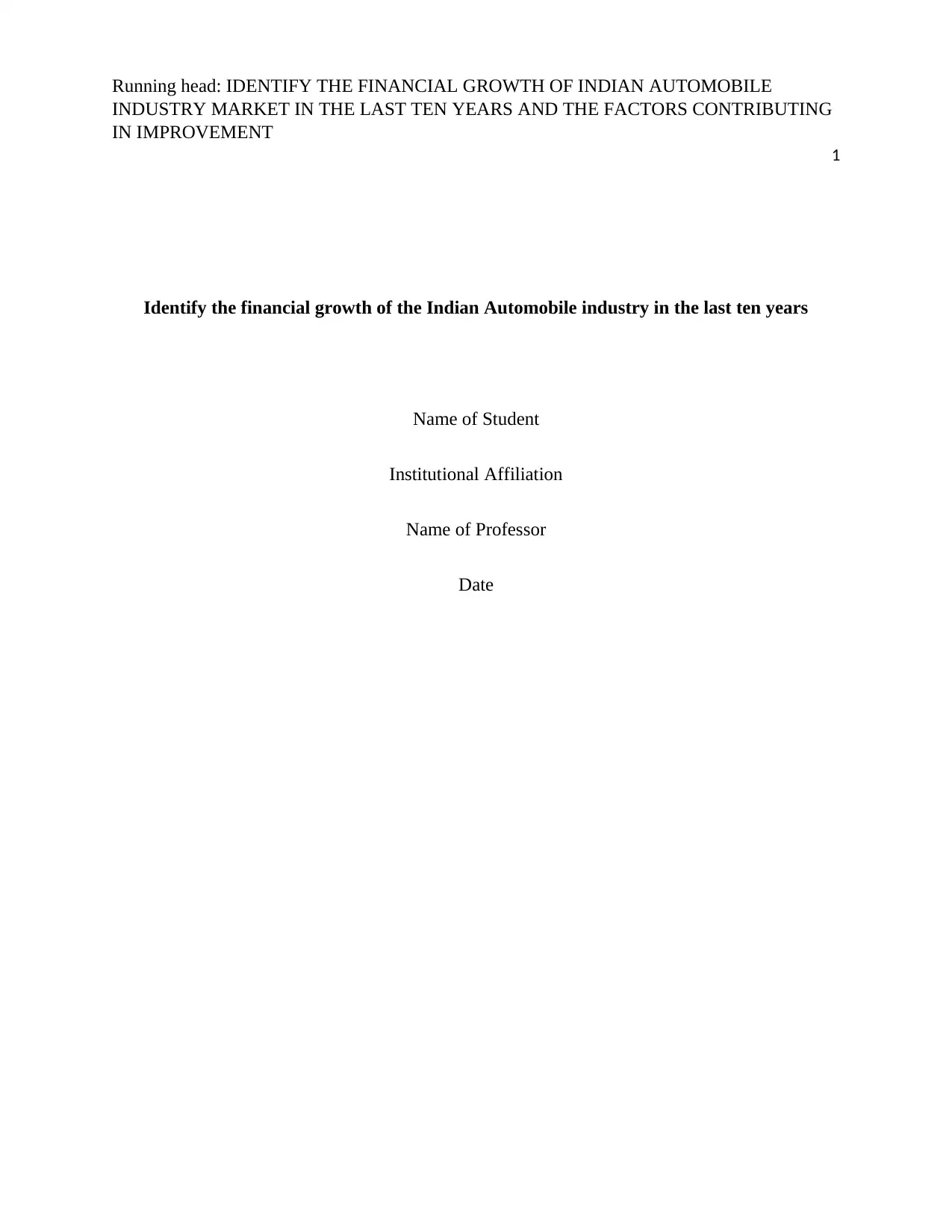
Running head: IDENTIFY THE FINANCIAL GROWTH OF INDIAN AUTOMOBILE
INDUSTRY MARKET IN THE LAST TEN YEARS AND THE FACTORS CONTRIBUTING
IN IMPROVEMENT
1
Identify the financial growth of the Indian Automobile industry in the last ten years
Name of Student
Institutional Affiliation
Name of Professor
Date
INDUSTRY MARKET IN THE LAST TEN YEARS AND THE FACTORS CONTRIBUTING
IN IMPROVEMENT
1
Identify the financial growth of the Indian Automobile industry in the last ten years
Name of Student
Institutional Affiliation
Name of Professor
Date
Paraphrase This Document
Need a fresh take? Get an instant paraphrase of this document with our AI Paraphraser
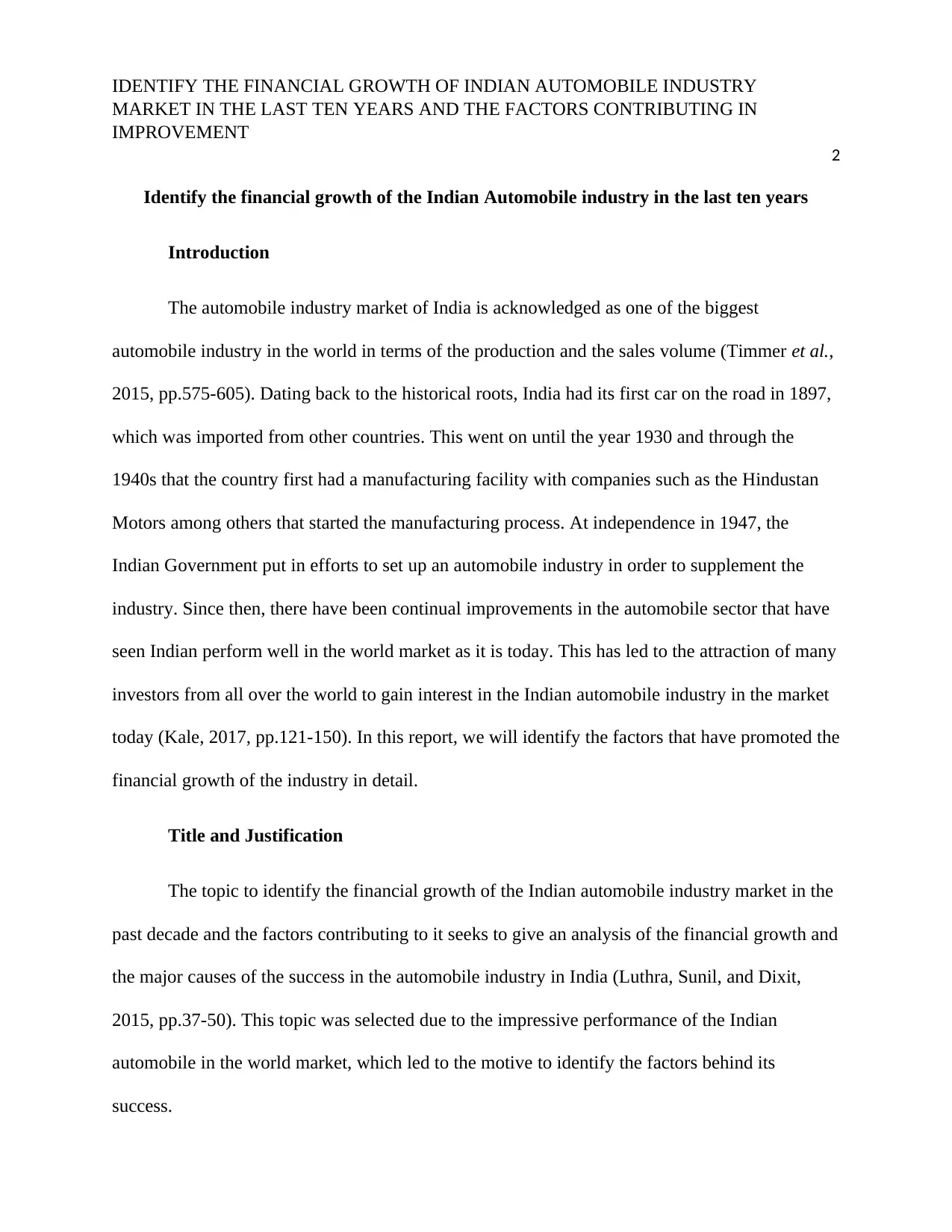
IDENTIFY THE FINANCIAL GROWTH OF INDIAN AUTOMOBILE INDUSTRY
MARKET IN THE LAST TEN YEARS AND THE FACTORS CONTRIBUTING IN
IMPROVEMENT
2
Identify the financial growth of the Indian Automobile industry in the last ten years
Introduction
The automobile industry market of India is acknowledged as one of the biggest
automobile industry in the world in terms of the production and the sales volume (Timmer et al.,
2015, pp.575-605). Dating back to the historical roots, India had its first car on the road in 1897,
which was imported from other countries. This went on until the year 1930 and through the
1940s that the country first had a manufacturing facility with companies such as the Hindustan
Motors among others that started the manufacturing process. At independence in 1947, the
Indian Government put in efforts to set up an automobile industry in order to supplement the
industry. Since then, there have been continual improvements in the automobile sector that have
seen Indian perform well in the world market as it is today. This has led to the attraction of many
investors from all over the world to gain interest in the Indian automobile industry in the market
today (Kale, 2017, pp.121-150). In this report, we will identify the factors that have promoted the
financial growth of the industry in detail.
Title and Justification
The topic to identify the financial growth of the Indian automobile industry market in the
past decade and the factors contributing to it seeks to give an analysis of the financial growth and
the major causes of the success in the automobile industry in India (Luthra, Sunil, and Dixit,
2015, pp.37-50). This topic was selected due to the impressive performance of the Indian
automobile in the world market, which led to the motive to identify the factors behind its
success.
MARKET IN THE LAST TEN YEARS AND THE FACTORS CONTRIBUTING IN
IMPROVEMENT
2
Identify the financial growth of the Indian Automobile industry in the last ten years
Introduction
The automobile industry market of India is acknowledged as one of the biggest
automobile industry in the world in terms of the production and the sales volume (Timmer et al.,
2015, pp.575-605). Dating back to the historical roots, India had its first car on the road in 1897,
which was imported from other countries. This went on until the year 1930 and through the
1940s that the country first had a manufacturing facility with companies such as the Hindustan
Motors among others that started the manufacturing process. At independence in 1947, the
Indian Government put in efforts to set up an automobile industry in order to supplement the
industry. Since then, there have been continual improvements in the automobile sector that have
seen Indian perform well in the world market as it is today. This has led to the attraction of many
investors from all over the world to gain interest in the Indian automobile industry in the market
today (Kale, 2017, pp.121-150). In this report, we will identify the factors that have promoted the
financial growth of the industry in detail.
Title and Justification
The topic to identify the financial growth of the Indian automobile industry market in the
past decade and the factors contributing to it seeks to give an analysis of the financial growth and
the major causes of the success in the automobile industry in India (Luthra, Sunil, and Dixit,
2015, pp.37-50). This topic was selected due to the impressive performance of the Indian
automobile in the world market, which led to the motive to identify the factors behind its
success.
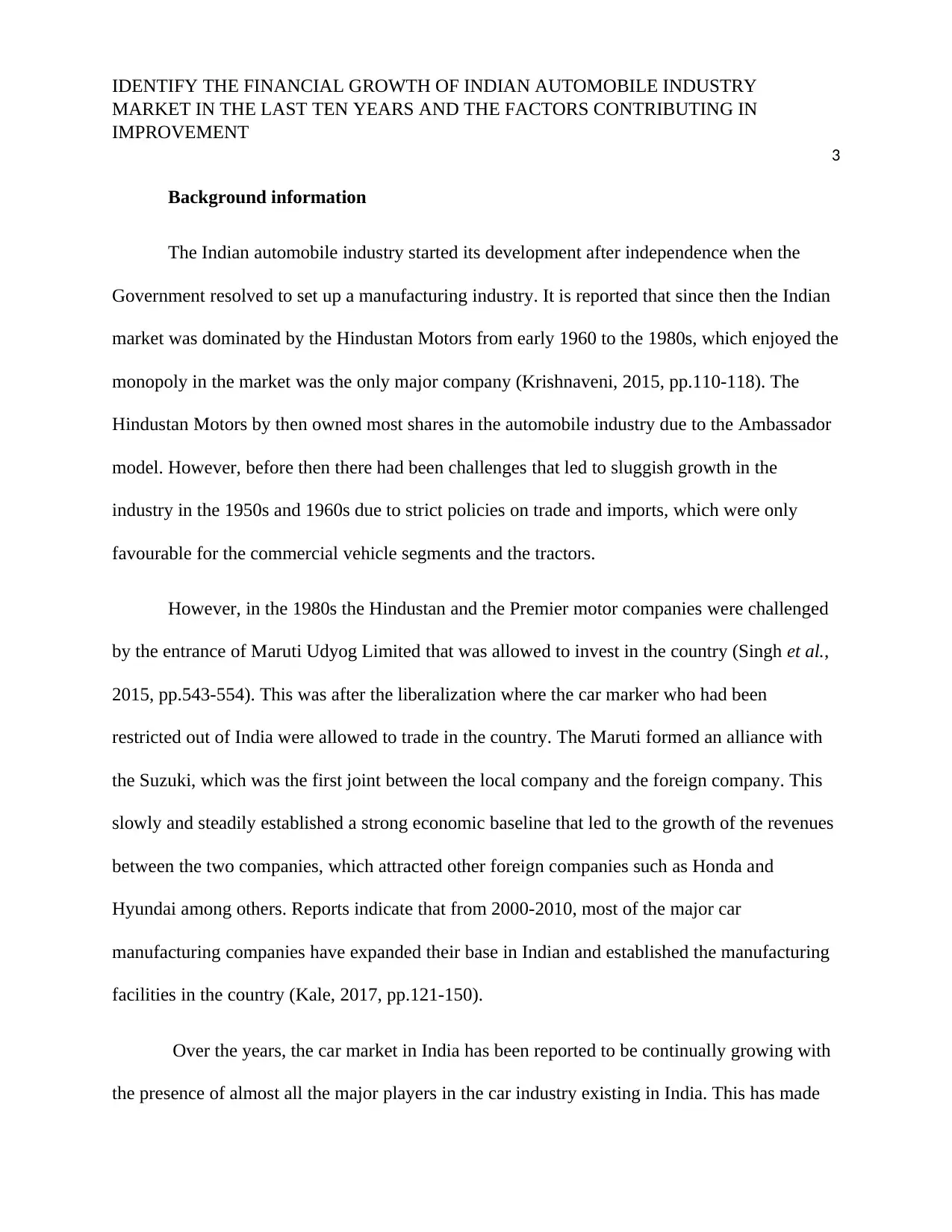
IDENTIFY THE FINANCIAL GROWTH OF INDIAN AUTOMOBILE INDUSTRY
MARKET IN THE LAST TEN YEARS AND THE FACTORS CONTRIBUTING IN
IMPROVEMENT
3
Background information
The Indian automobile industry started its development after independence when the
Government resolved to set up a manufacturing industry. It is reported that since then the Indian
market was dominated by the Hindustan Motors from early 1960 to the 1980s, which enjoyed the
monopoly in the market was the only major company (Krishnaveni, 2015, pp.110-118). The
Hindustan Motors by then owned most shares in the automobile industry due to the Ambassador
model. However, before then there had been challenges that led to sluggish growth in the
industry in the 1950s and 1960s due to strict policies on trade and imports, which were only
favourable for the commercial vehicle segments and the tractors.
However, in the 1980s the Hindustan and the Premier motor companies were challenged
by the entrance of Maruti Udyog Limited that was allowed to invest in the country (Singh et al.,
2015, pp.543-554). This was after the liberalization where the car marker who had been
restricted out of India were allowed to trade in the country. The Maruti formed an alliance with
the Suzuki, which was the first joint between the local company and the foreign company. This
slowly and steadily established a strong economic baseline that led to the growth of the revenues
between the two companies, which attracted other foreign companies such as Honda and
Hyundai among others. Reports indicate that from 2000-2010, most of the major car
manufacturing companies have expanded their base in Indian and established the manufacturing
facilities in the country (Kale, 2017, pp.121-150).
Over the years, the car market in India has been reported to be continually growing with
the presence of almost all the major players in the car industry existing in India. This has made
MARKET IN THE LAST TEN YEARS AND THE FACTORS CONTRIBUTING IN
IMPROVEMENT
3
Background information
The Indian automobile industry started its development after independence when the
Government resolved to set up a manufacturing industry. It is reported that since then the Indian
market was dominated by the Hindustan Motors from early 1960 to the 1980s, which enjoyed the
monopoly in the market was the only major company (Krishnaveni, 2015, pp.110-118). The
Hindustan Motors by then owned most shares in the automobile industry due to the Ambassador
model. However, before then there had been challenges that led to sluggish growth in the
industry in the 1950s and 1960s due to strict policies on trade and imports, which were only
favourable for the commercial vehicle segments and the tractors.
However, in the 1980s the Hindustan and the Premier motor companies were challenged
by the entrance of Maruti Udyog Limited that was allowed to invest in the country (Singh et al.,
2015, pp.543-554). This was after the liberalization where the car marker who had been
restricted out of India were allowed to trade in the country. The Maruti formed an alliance with
the Suzuki, which was the first joint between the local company and the foreign company. This
slowly and steadily established a strong economic baseline that led to the growth of the revenues
between the two companies, which attracted other foreign companies such as Honda and
Hyundai among others. Reports indicate that from 2000-2010, most of the major car
manufacturing companies have expanded their base in Indian and established the manufacturing
facilities in the country (Kale, 2017, pp.121-150).
Over the years, the car market in India has been reported to be continually growing with
the presence of almost all the major players in the car industry existing in India. This has made
⊘ This is a preview!⊘
Do you want full access?
Subscribe today to unlock all pages.

Trusted by 1+ million students worldwide
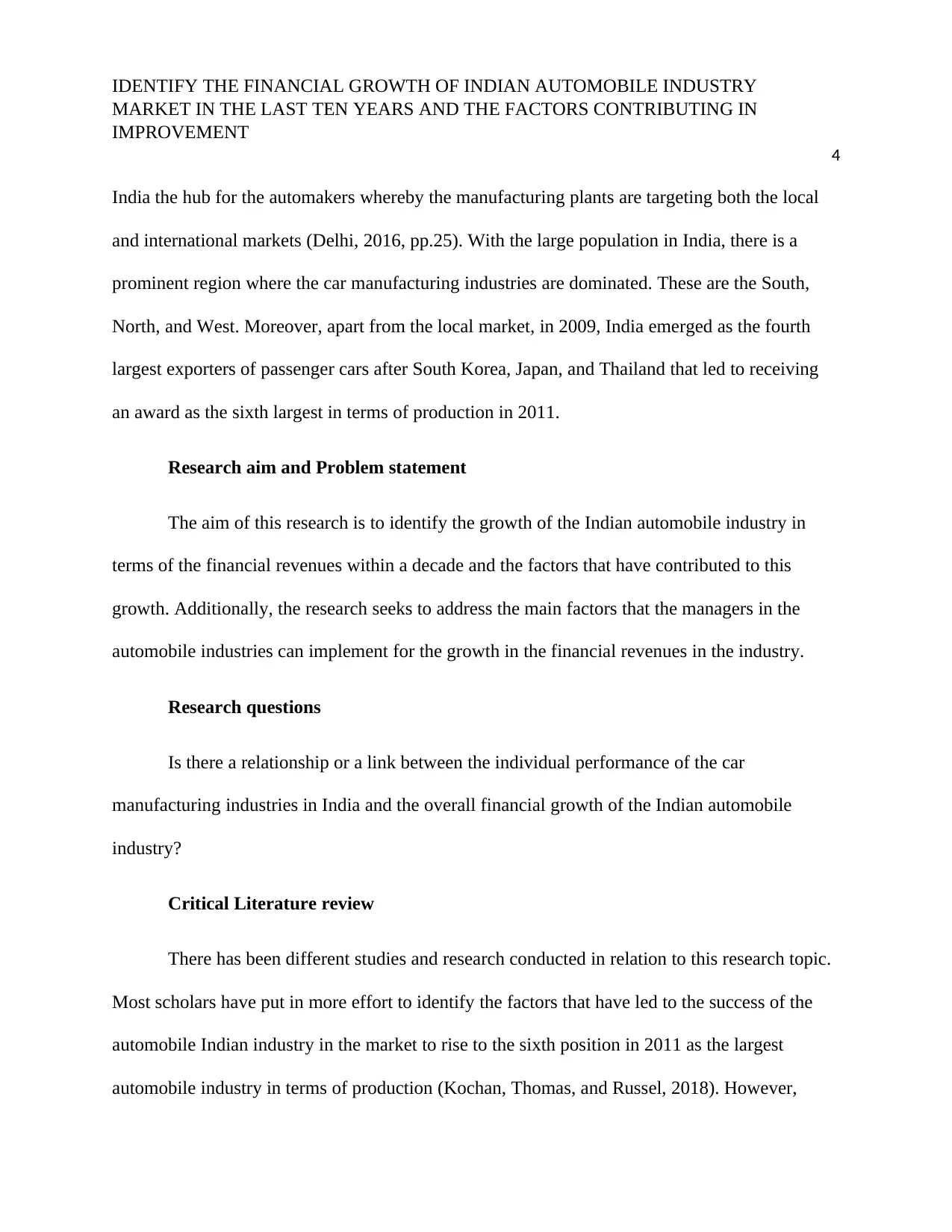
IDENTIFY THE FINANCIAL GROWTH OF INDIAN AUTOMOBILE INDUSTRY
MARKET IN THE LAST TEN YEARS AND THE FACTORS CONTRIBUTING IN
IMPROVEMENT
4
India the hub for the automakers whereby the manufacturing plants are targeting both the local
and international markets (Delhi, 2016, pp.25). With the large population in India, there is a
prominent region where the car manufacturing industries are dominated. These are the South,
North, and West. Moreover, apart from the local market, in 2009, India emerged as the fourth
largest exporters of passenger cars after South Korea, Japan, and Thailand that led to receiving
an award as the sixth largest in terms of production in 2011.
Research aim and Problem statement
The aim of this research is to identify the growth of the Indian automobile industry in
terms of the financial revenues within a decade and the factors that have contributed to this
growth. Additionally, the research seeks to address the main factors that the managers in the
automobile industries can implement for the growth in the financial revenues in the industry.
Research questions
Is there a relationship or a link between the individual performance of the car
manufacturing industries in India and the overall financial growth of the Indian automobile
industry?
Critical Literature review
There has been different studies and research conducted in relation to this research topic.
Most scholars have put in more effort to identify the factors that have led to the success of the
automobile Indian industry in the market to rise to the sixth position in 2011 as the largest
automobile industry in terms of production (Kochan, Thomas, and Russel, 2018). However,
MARKET IN THE LAST TEN YEARS AND THE FACTORS CONTRIBUTING IN
IMPROVEMENT
4
India the hub for the automakers whereby the manufacturing plants are targeting both the local
and international markets (Delhi, 2016, pp.25). With the large population in India, there is a
prominent region where the car manufacturing industries are dominated. These are the South,
North, and West. Moreover, apart from the local market, in 2009, India emerged as the fourth
largest exporters of passenger cars after South Korea, Japan, and Thailand that led to receiving
an award as the sixth largest in terms of production in 2011.
Research aim and Problem statement
The aim of this research is to identify the growth of the Indian automobile industry in
terms of the financial revenues within a decade and the factors that have contributed to this
growth. Additionally, the research seeks to address the main factors that the managers in the
automobile industries can implement for the growth in the financial revenues in the industry.
Research questions
Is there a relationship or a link between the individual performance of the car
manufacturing industries in India and the overall financial growth of the Indian automobile
industry?
Critical Literature review
There has been different studies and research conducted in relation to this research topic.
Most scholars have put in more effort to identify the factors that have led to the success of the
automobile Indian industry in the market to rise to the sixth position in 2011 as the largest
automobile industry in terms of production (Kochan, Thomas, and Russel, 2018). However,
Paraphrase This Document
Need a fresh take? Get an instant paraphrase of this document with our AI Paraphraser
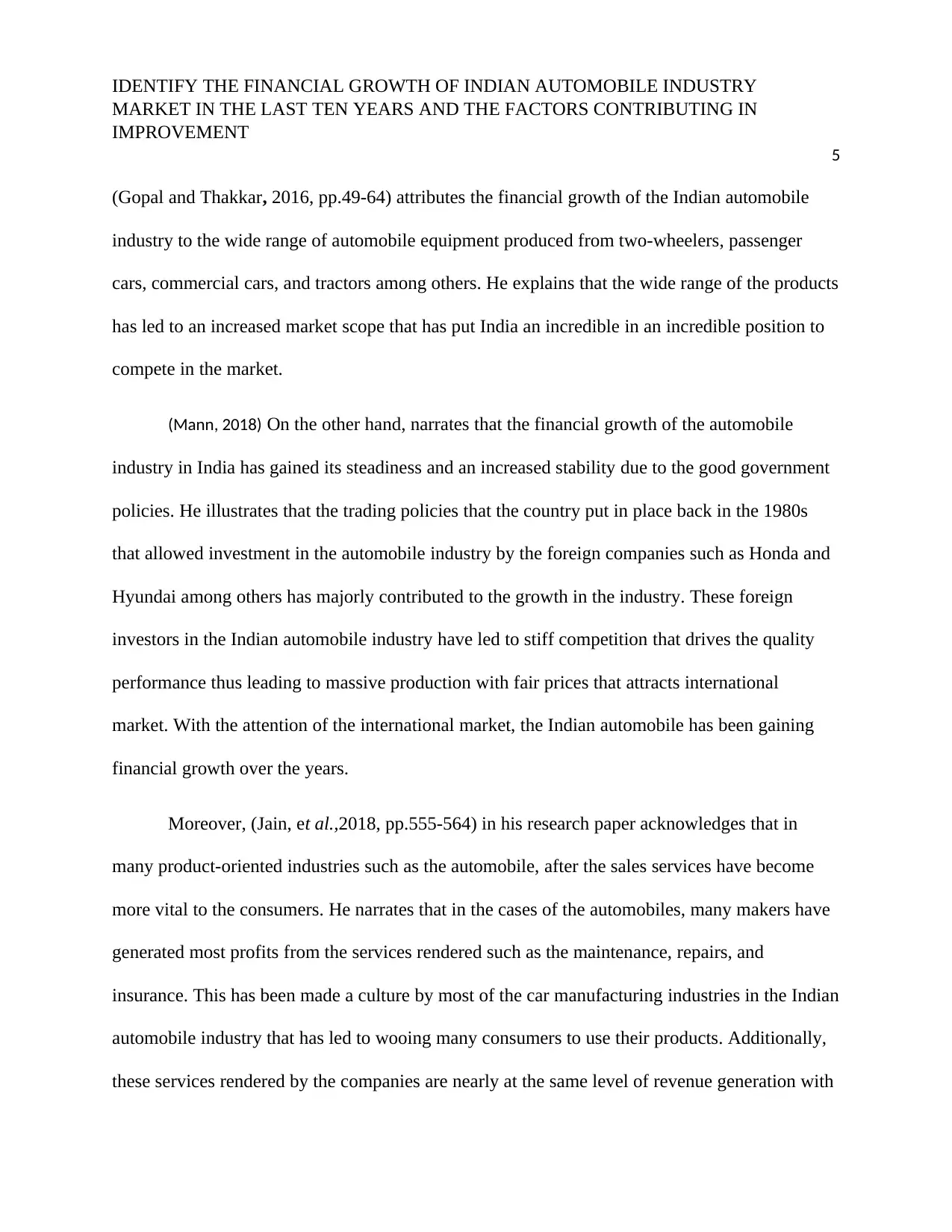
IDENTIFY THE FINANCIAL GROWTH OF INDIAN AUTOMOBILE INDUSTRY
MARKET IN THE LAST TEN YEARS AND THE FACTORS CONTRIBUTING IN
IMPROVEMENT
5
(Gopal and Thakkar, 2016, pp.49-64) attributes the financial growth of the Indian automobile
industry to the wide range of automobile equipment produced from two-wheelers, passenger
cars, commercial cars, and tractors among others. He explains that the wide range of the products
has led to an increased market scope that has put India an incredible in an incredible position to
compete in the market.
(Mann, 2018) On the other hand, narrates that the financial growth of the automobile
industry in India has gained its steadiness and an increased stability due to the good government
policies. He illustrates that the trading policies that the country put in place back in the 1980s
that allowed investment in the automobile industry by the foreign companies such as Honda and
Hyundai among others has majorly contributed to the growth in the industry. These foreign
investors in the Indian automobile industry have led to stiff competition that drives the quality
performance thus leading to massive production with fair prices that attracts international
market. With the attention of the international market, the Indian automobile has been gaining
financial growth over the years.
Moreover, (Jain, et al.,2018, pp.555-564) in his research paper acknowledges that in
many product-oriented industries such as the automobile, after the sales services have become
more vital to the consumers. He narrates that in the cases of the automobiles, many makers have
generated most profits from the services rendered such as the maintenance, repairs, and
insurance. This has been made a culture by most of the car manufacturing industries in the Indian
automobile industry that has led to wooing many consumers to use their products. Additionally,
these services rendered by the companies are nearly at the same level of revenue generation with
MARKET IN THE LAST TEN YEARS AND THE FACTORS CONTRIBUTING IN
IMPROVEMENT
5
(Gopal and Thakkar, 2016, pp.49-64) attributes the financial growth of the Indian automobile
industry to the wide range of automobile equipment produced from two-wheelers, passenger
cars, commercial cars, and tractors among others. He explains that the wide range of the products
has led to an increased market scope that has put India an incredible in an incredible position to
compete in the market.
(Mann, 2018) On the other hand, narrates that the financial growth of the automobile
industry in India has gained its steadiness and an increased stability due to the good government
policies. He illustrates that the trading policies that the country put in place back in the 1980s
that allowed investment in the automobile industry by the foreign companies such as Honda and
Hyundai among others has majorly contributed to the growth in the industry. These foreign
investors in the Indian automobile industry have led to stiff competition that drives the quality
performance thus leading to massive production with fair prices that attracts international
market. With the attention of the international market, the Indian automobile has been gaining
financial growth over the years.
Moreover, (Jain, et al.,2018, pp.555-564) in his research paper acknowledges that in
many product-oriented industries such as the automobile, after the sales services have become
more vital to the consumers. He narrates that in the cases of the automobiles, many makers have
generated most profits from the services rendered such as the maintenance, repairs, and
insurance. This has been made a culture by most of the car manufacturing industries in the Indian
automobile industry that has led to wooing many consumers to use their products. Additionally,
these services rendered by the companies are nearly at the same level of revenue generation with
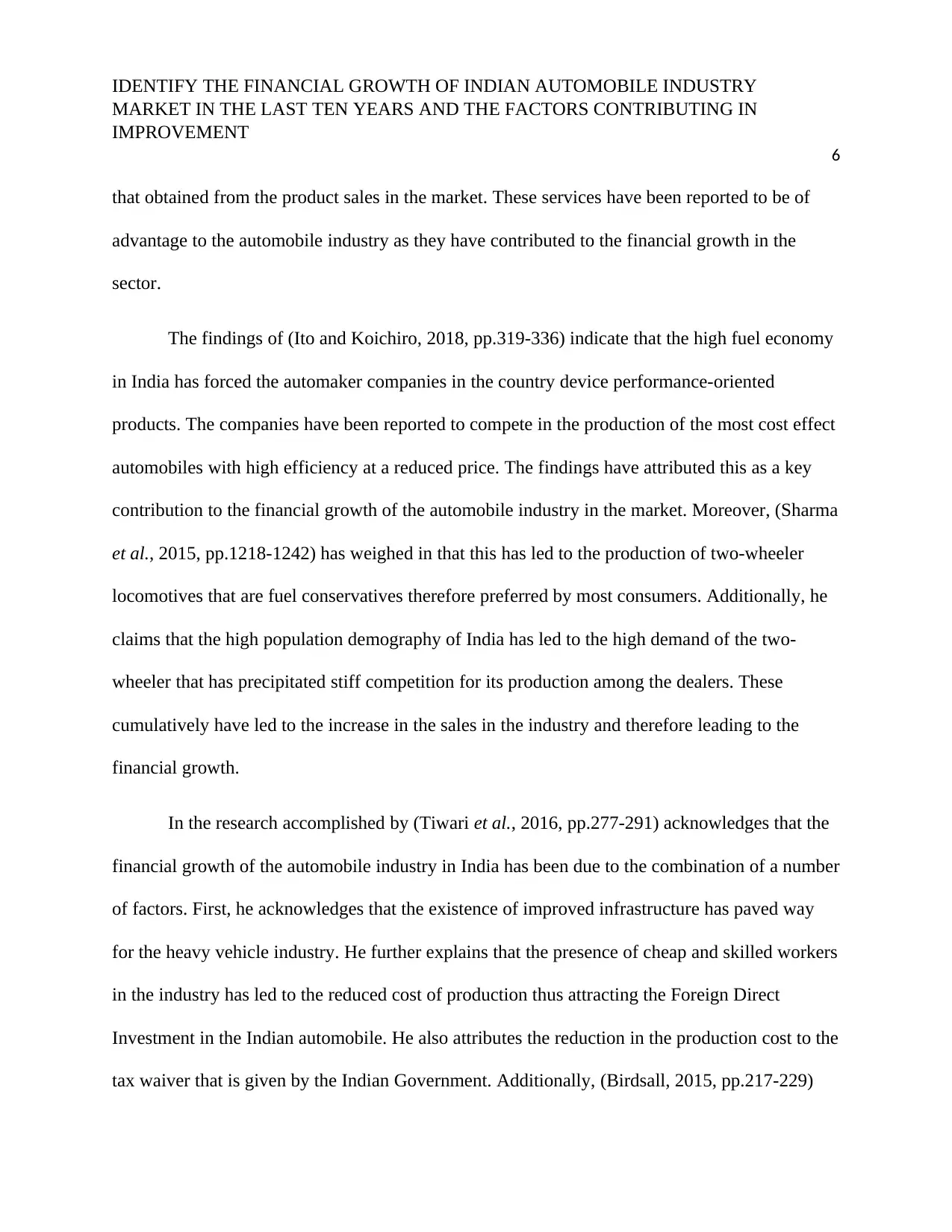
IDENTIFY THE FINANCIAL GROWTH OF INDIAN AUTOMOBILE INDUSTRY
MARKET IN THE LAST TEN YEARS AND THE FACTORS CONTRIBUTING IN
IMPROVEMENT
6
that obtained from the product sales in the market. These services have been reported to be of
advantage to the automobile industry as they have contributed to the financial growth in the
sector.
The findings of (Ito and Koichiro, 2018, pp.319-336) indicate that the high fuel economy
in India has forced the automaker companies in the country device performance-oriented
products. The companies have been reported to compete in the production of the most cost effect
automobiles with high efficiency at a reduced price. The findings have attributed this as a key
contribution to the financial growth of the automobile industry in the market. Moreover, (Sharma
et al., 2015, pp.1218-1242) has weighed in that this has led to the production of two-wheeler
locomotives that are fuel conservatives therefore preferred by most consumers. Additionally, he
claims that the high population demography of India has led to the high demand of the two-
wheeler that has precipitated stiff competition for its production among the dealers. These
cumulatively have led to the increase in the sales in the industry and therefore leading to the
financial growth.
In the research accomplished by (Tiwari et al., 2016, pp.277-291) acknowledges that the
financial growth of the automobile industry in India has been due to the combination of a number
of factors. First, he acknowledges that the existence of improved infrastructure has paved way
for the heavy vehicle industry. He further explains that the presence of cheap and skilled workers
in the industry has led to the reduced cost of production thus attracting the Foreign Direct
Investment in the Indian automobile. He also attributes the reduction in the production cost to the
tax waiver that is given by the Indian Government. Additionally, (Birdsall, 2015, pp.217-229)
MARKET IN THE LAST TEN YEARS AND THE FACTORS CONTRIBUTING IN
IMPROVEMENT
6
that obtained from the product sales in the market. These services have been reported to be of
advantage to the automobile industry as they have contributed to the financial growth in the
sector.
The findings of (Ito and Koichiro, 2018, pp.319-336) indicate that the high fuel economy
in India has forced the automaker companies in the country device performance-oriented
products. The companies have been reported to compete in the production of the most cost effect
automobiles with high efficiency at a reduced price. The findings have attributed this as a key
contribution to the financial growth of the automobile industry in the market. Moreover, (Sharma
et al., 2015, pp.1218-1242) has weighed in that this has led to the production of two-wheeler
locomotives that are fuel conservatives therefore preferred by most consumers. Additionally, he
claims that the high population demography of India has led to the high demand of the two-
wheeler that has precipitated stiff competition for its production among the dealers. These
cumulatively have led to the increase in the sales in the industry and therefore leading to the
financial growth.
In the research accomplished by (Tiwari et al., 2016, pp.277-291) acknowledges that the
financial growth of the automobile industry in India has been due to the combination of a number
of factors. First, he acknowledges that the existence of improved infrastructure has paved way
for the heavy vehicle industry. He further explains that the presence of cheap and skilled workers
in the industry has led to the reduced cost of production thus attracting the Foreign Direct
Investment in the Indian automobile. He also attributes the reduction in the production cost to the
tax waiver that is given by the Indian Government. Additionally, (Birdsall, 2015, pp.217-229)
⊘ This is a preview!⊘
Do you want full access?
Subscribe today to unlock all pages.

Trusted by 1+ million students worldwide
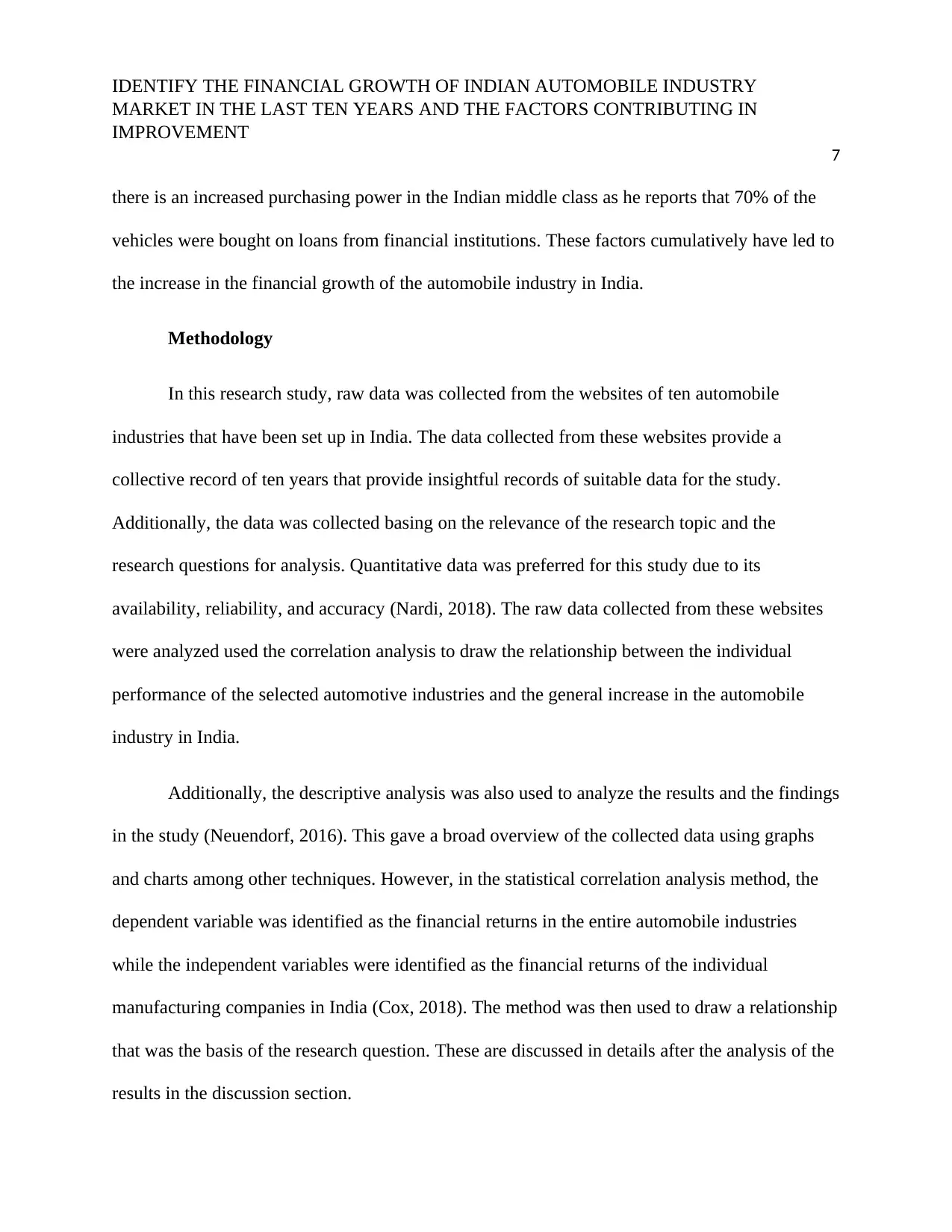
IDENTIFY THE FINANCIAL GROWTH OF INDIAN AUTOMOBILE INDUSTRY
MARKET IN THE LAST TEN YEARS AND THE FACTORS CONTRIBUTING IN
IMPROVEMENT
7
there is an increased purchasing power in the Indian middle class as he reports that 70% of the
vehicles were bought on loans from financial institutions. These factors cumulatively have led to
the increase in the financial growth of the automobile industry in India.
Methodology
In this research study, raw data was collected from the websites of ten automobile
industries that have been set up in India. The data collected from these websites provide a
collective record of ten years that provide insightful records of suitable data for the study.
Additionally, the data was collected basing on the relevance of the research topic and the
research questions for analysis. Quantitative data was preferred for this study due to its
availability, reliability, and accuracy (Nardi, 2018). The raw data collected from these websites
were analyzed used the correlation analysis to draw the relationship between the individual
performance of the selected automotive industries and the general increase in the automobile
industry in India.
Additionally, the descriptive analysis was also used to analyze the results and the findings
in the study (Neuendorf, 2016). This gave a broad overview of the collected data using graphs
and charts among other techniques. However, in the statistical correlation analysis method, the
dependent variable was identified as the financial returns in the entire automobile industries
while the independent variables were identified as the financial returns of the individual
manufacturing companies in India (Cox, 2018). The method was then used to draw a relationship
that was the basis of the research question. These are discussed in details after the analysis of the
results in the discussion section.
MARKET IN THE LAST TEN YEARS AND THE FACTORS CONTRIBUTING IN
IMPROVEMENT
7
there is an increased purchasing power in the Indian middle class as he reports that 70% of the
vehicles were bought on loans from financial institutions. These factors cumulatively have led to
the increase in the financial growth of the automobile industry in India.
Methodology
In this research study, raw data was collected from the websites of ten automobile
industries that have been set up in India. The data collected from these websites provide a
collective record of ten years that provide insightful records of suitable data for the study.
Additionally, the data was collected basing on the relevance of the research topic and the
research questions for analysis. Quantitative data was preferred for this study due to its
availability, reliability, and accuracy (Nardi, 2018). The raw data collected from these websites
were analyzed used the correlation analysis to draw the relationship between the individual
performance of the selected automotive industries and the general increase in the automobile
industry in India.
Additionally, the descriptive analysis was also used to analyze the results and the findings
in the study (Neuendorf, 2016). This gave a broad overview of the collected data using graphs
and charts among other techniques. However, in the statistical correlation analysis method, the
dependent variable was identified as the financial returns in the entire automobile industries
while the independent variables were identified as the financial returns of the individual
manufacturing companies in India (Cox, 2018). The method was then used to draw a relationship
that was the basis of the research question. These are discussed in details after the analysis of the
results in the discussion section.
Paraphrase This Document
Need a fresh take? Get an instant paraphrase of this document with our AI Paraphraser
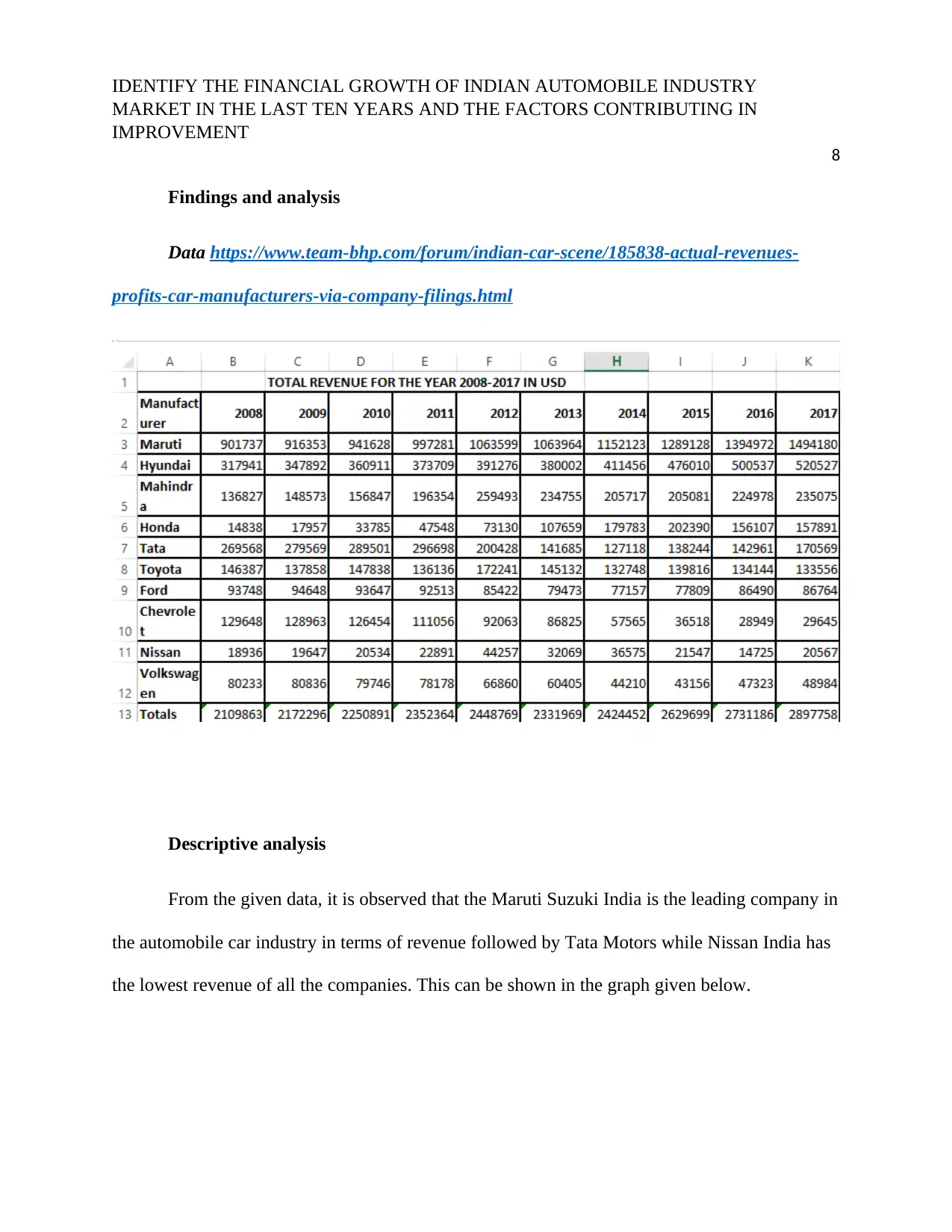
IDENTIFY THE FINANCIAL GROWTH OF INDIAN AUTOMOBILE INDUSTRY
MARKET IN THE LAST TEN YEARS AND THE FACTORS CONTRIBUTING IN
IMPROVEMENT
8
Findings and analysis
Data https://www.team-bhp.com/forum/indian-car-scene/185838-actual-revenues-
profits-car-manufacturers-via-company-filings.html
Descriptive analysis
From the given data, it is observed that the Maruti Suzuki India is the leading company in
the automobile car industry in terms of revenue followed by Tata Motors while Nissan India has
the lowest revenue of all the companies. This can be shown in the graph given below.
MARKET IN THE LAST TEN YEARS AND THE FACTORS CONTRIBUTING IN
IMPROVEMENT
8
Findings and analysis
Data https://www.team-bhp.com/forum/indian-car-scene/185838-actual-revenues-
profits-car-manufacturers-via-company-filings.html
Descriptive analysis
From the given data, it is observed that the Maruti Suzuki India is the leading company in
the automobile car industry in terms of revenue followed by Tata Motors while Nissan India has
the lowest revenue of all the companies. This can be shown in the graph given below.
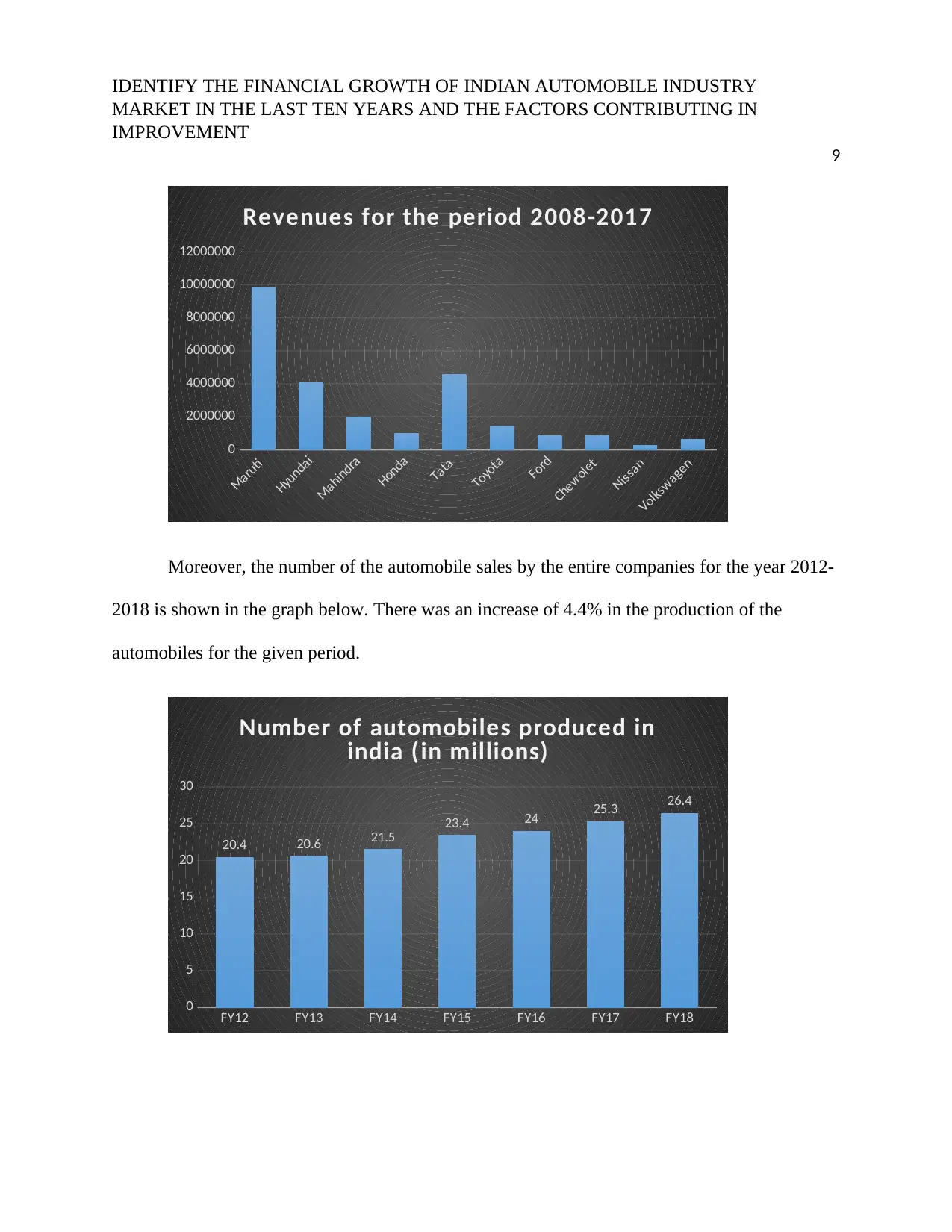
IDENTIFY THE FINANCIAL GROWTH OF INDIAN AUTOMOBILE INDUSTRY
MARKET IN THE LAST TEN YEARS AND THE FACTORS CONTRIBUTING IN
IMPROVEMENT
9
Maruti
Hyundai
Mahindra
Honda
Tata
Toyota
Ford
Chevrolet
Nissan
Volkswagen
0
2000000
4000000
6000000
8000000
10000000
12000000
Revenues for the period 2008-2017
Moreover, the number of the automobile sales by the entire companies for the year 2012-
2018 is shown in the graph below. There was an increase of 4.4% in the production of the
automobiles for the given period.
FY12 FY13 FY14 FY15 FY16 FY17 FY18
0
5
10
15
20
25
30
20.4 20.6 21.5 23.4 24 25.3 26.4
Number of automobiles produced in
india (in millions)
MARKET IN THE LAST TEN YEARS AND THE FACTORS CONTRIBUTING IN
IMPROVEMENT
9
Maruti
Hyundai
Mahindra
Honda
Tata
Toyota
Ford
Chevrolet
Nissan
Volkswagen
0
2000000
4000000
6000000
8000000
10000000
12000000
Revenues for the period 2008-2017
Moreover, the number of the automobile sales by the entire companies for the year 2012-
2018 is shown in the graph below. There was an increase of 4.4% in the production of the
automobiles for the given period.
FY12 FY13 FY14 FY15 FY16 FY17 FY18
0
5
10
15
20
25
30
20.4 20.6 21.5 23.4 24 25.3 26.4
Number of automobiles produced in
india (in millions)
⊘ This is a preview!⊘
Do you want full access?
Subscribe today to unlock all pages.

Trusted by 1+ million students worldwide
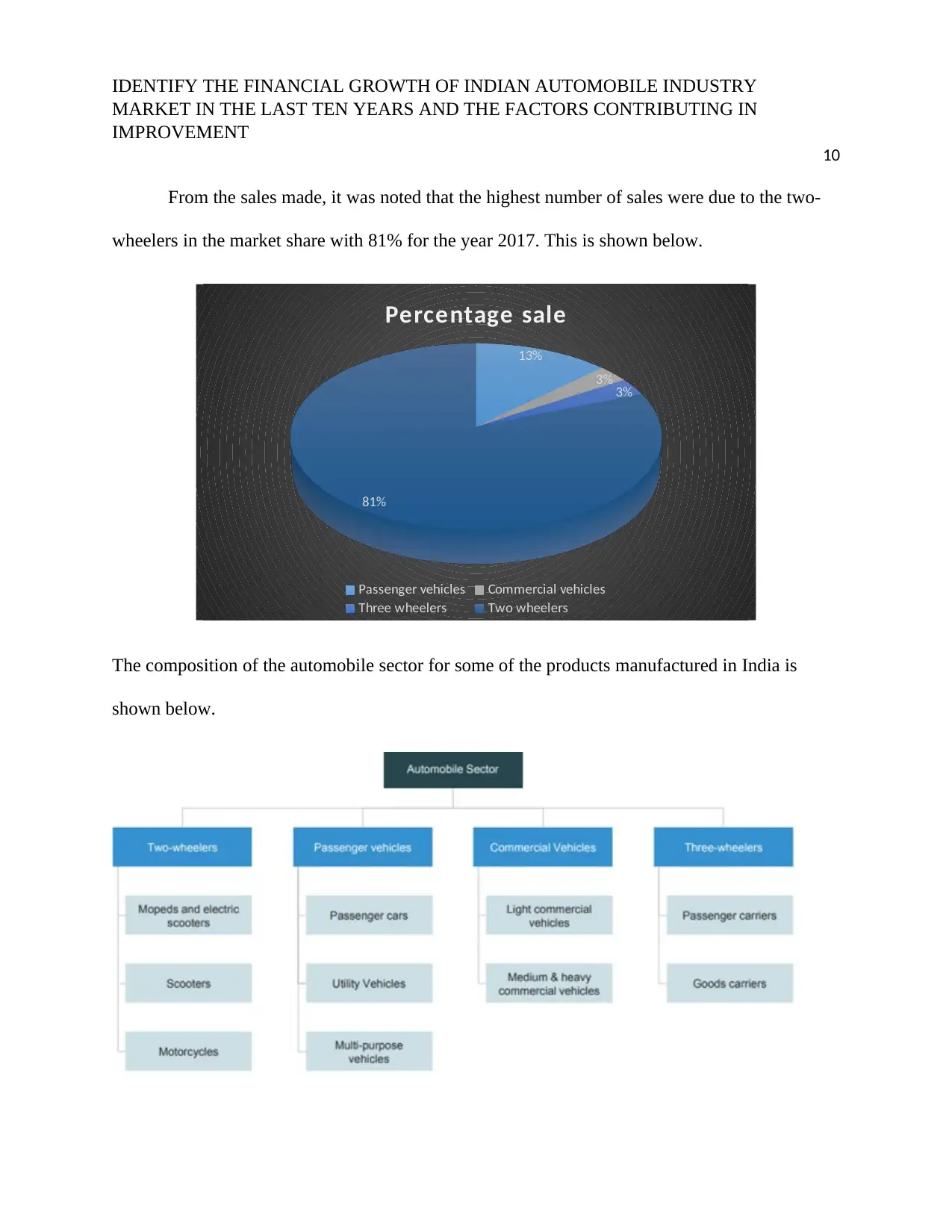
IDENTIFY THE FINANCIAL GROWTH OF INDIAN AUTOMOBILE INDUSTRY
MARKET IN THE LAST TEN YEARS AND THE FACTORS CONTRIBUTING IN
IMPROVEMENT
10
From the sales made, it was noted that the highest number of sales were due to the two-
wheelers in the market share with 81% for the year 2017. This is shown below.
13%
3% 3%
81%
Percentage sale
Passenger vehicles Commercial vehicles
Three wheelers Two wheelers
The composition of the automobile sector for some of the products manufactured in India is
shown below.
MARKET IN THE LAST TEN YEARS AND THE FACTORS CONTRIBUTING IN
IMPROVEMENT
10
From the sales made, it was noted that the highest number of sales were due to the two-
wheelers in the market share with 81% for the year 2017. This is shown below.
13%
3% 3%
81%
Percentage sale
Passenger vehicles Commercial vehicles
Three wheelers Two wheelers
The composition of the automobile sector for some of the products manufactured in India is
shown below.
Paraphrase This Document
Need a fresh take? Get an instant paraphrase of this document with our AI Paraphraser
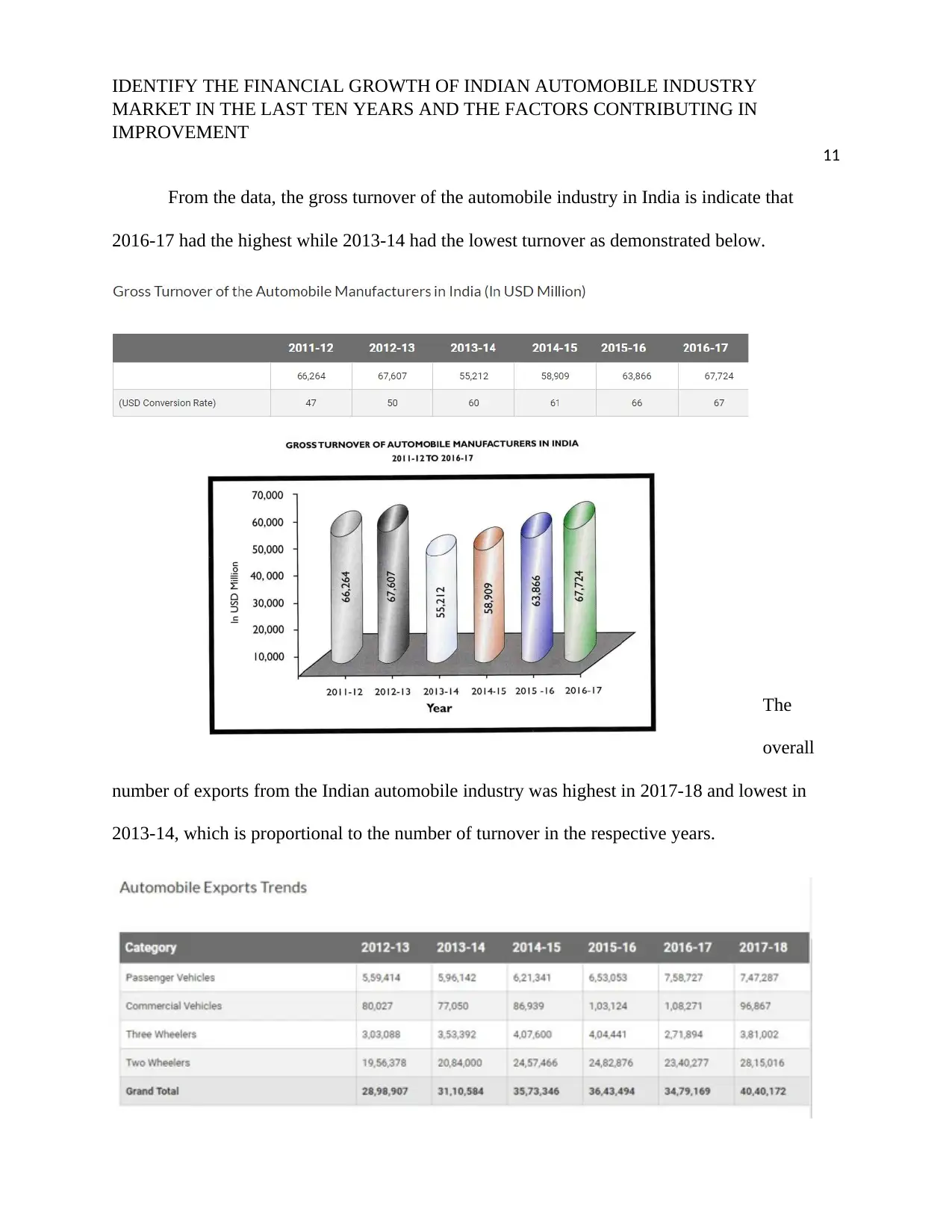
IDENTIFY THE FINANCIAL GROWTH OF INDIAN AUTOMOBILE INDUSTRY
MARKET IN THE LAST TEN YEARS AND THE FACTORS CONTRIBUTING IN
IMPROVEMENT
11
From the data, the gross turnover of the automobile industry in India is indicate that
2016-17 had the highest while 2013-14 had the lowest turnover as demonstrated below.
The
overall
number of exports from the Indian automobile industry was highest in 2017-18 and lowest in
2013-14, which is proportional to the number of turnover in the respective years.
MARKET IN THE LAST TEN YEARS AND THE FACTORS CONTRIBUTING IN
IMPROVEMENT
11
From the data, the gross turnover of the automobile industry in India is indicate that
2016-17 had the highest while 2013-14 had the lowest turnover as demonstrated below.
The
overall
number of exports from the Indian automobile industry was highest in 2017-18 and lowest in
2013-14, which is proportional to the number of turnover in the respective years.
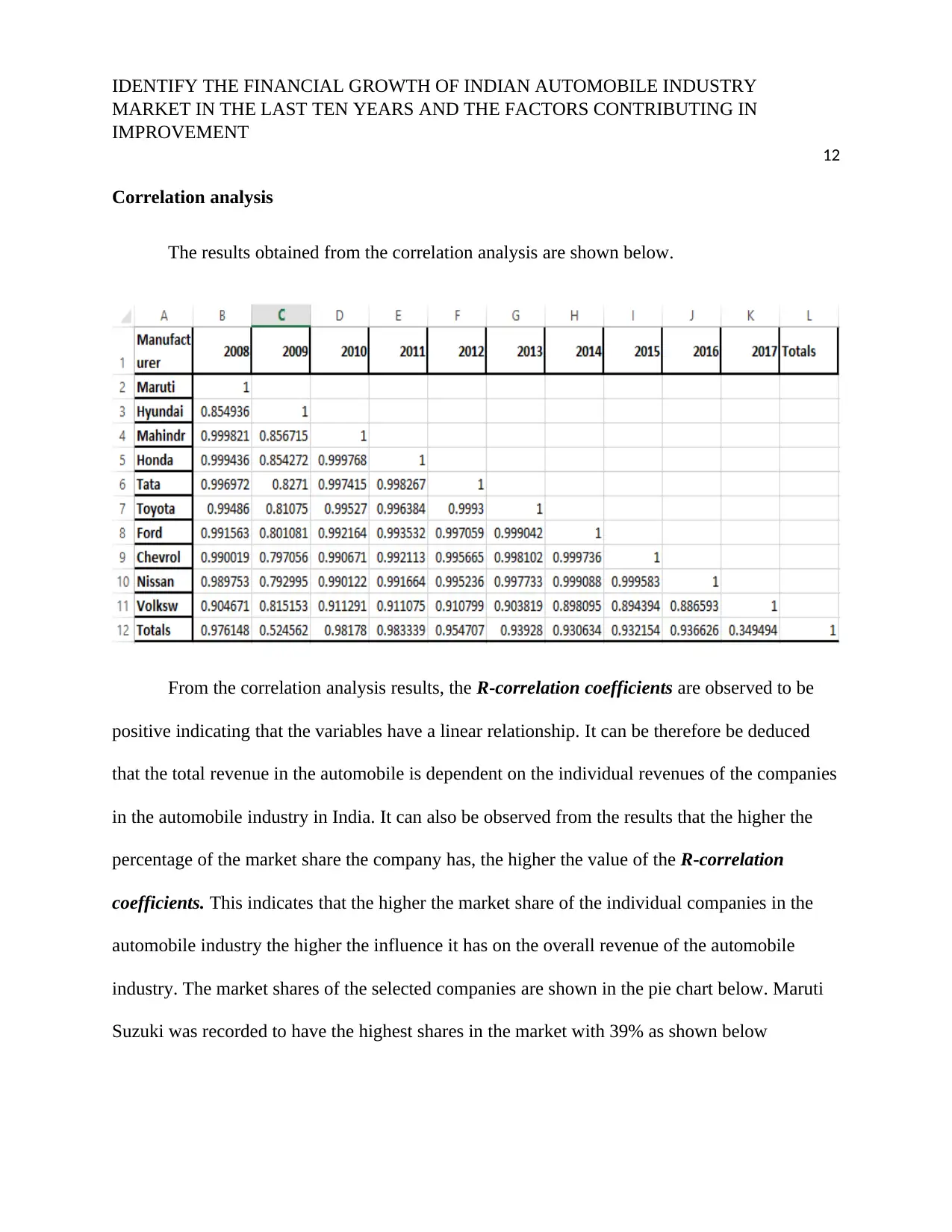
IDENTIFY THE FINANCIAL GROWTH OF INDIAN AUTOMOBILE INDUSTRY
MARKET IN THE LAST TEN YEARS AND THE FACTORS CONTRIBUTING IN
IMPROVEMENT
12
Correlation analysis
The results obtained from the correlation analysis are shown below.
From the correlation analysis results, the R-correlation coefficients are observed to be
positive indicating that the variables have a linear relationship. It can be therefore be deduced
that the total revenue in the automobile is dependent on the individual revenues of the companies
in the automobile industry in India. It can also be observed from the results that the higher the
percentage of the market share the company has, the higher the value of the R-correlation
coefficients. This indicates that the higher the market share of the individual companies in the
automobile industry the higher the influence it has on the overall revenue of the automobile
industry. The market shares of the selected companies are shown in the pie chart below. Maruti
Suzuki was recorded to have the highest shares in the market with 39% as shown below
MARKET IN THE LAST TEN YEARS AND THE FACTORS CONTRIBUTING IN
IMPROVEMENT
12
Correlation analysis
The results obtained from the correlation analysis are shown below.
From the correlation analysis results, the R-correlation coefficients are observed to be
positive indicating that the variables have a linear relationship. It can be therefore be deduced
that the total revenue in the automobile is dependent on the individual revenues of the companies
in the automobile industry in India. It can also be observed from the results that the higher the
percentage of the market share the company has, the higher the value of the R-correlation
coefficients. This indicates that the higher the market share of the individual companies in the
automobile industry the higher the influence it has on the overall revenue of the automobile
industry. The market shares of the selected companies are shown in the pie chart below. Maruti
Suzuki was recorded to have the highest shares in the market with 39% as shown below
⊘ This is a preview!⊘
Do you want full access?
Subscribe today to unlock all pages.

Trusted by 1+ million students worldwide
1 out of 19
Related Documents
Your All-in-One AI-Powered Toolkit for Academic Success.
+13062052269
info@desklib.com
Available 24*7 on WhatsApp / Email
![[object Object]](/_next/static/media/star-bottom.7253800d.svg)
Unlock your academic potential
Copyright © 2020–2025 A2Z Services. All Rights Reserved. Developed and managed by ZUCOL.





